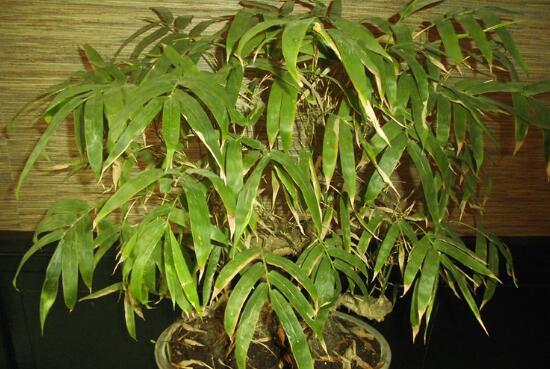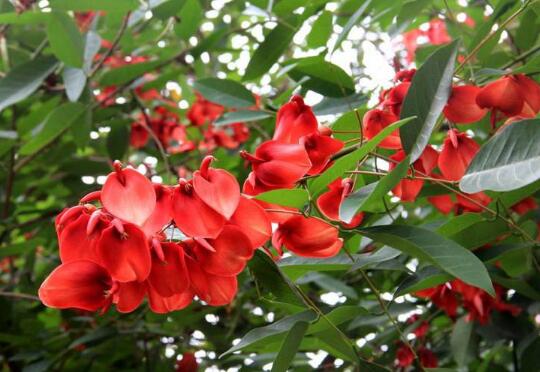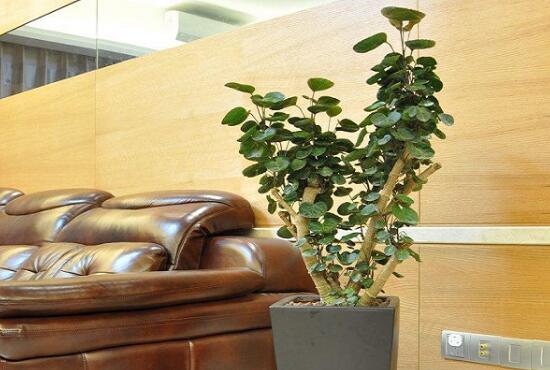How to deal with yellow leaves of Podocarpus, summer shade/reasonable watering/pest spray
Luohan bamboo, which is different from ordinary bamboo, has thin knots and short and inflated internodes, just like a folded Luohan, hence its name. In life, there are many people who raise Luohan bamboo. Looking at its peculiar bamboo knots and green leaves makes people feel happy, so when the yellow leaves appear, the flower friends are very bad! So, what if the leaves of Luohan bamboo turn yellow? Today, the editor is here to solve this problem for you.
What if the leaves of Luohan bamboo turn yellow

To say that the leaves of Luohan bamboo turn yellow, in addition to environmental discomfort, it is caused by improper maintenance: if the light is too strong, it needs proper shading; if it is watered too much, it is necessary to loosen the soil, and when there are rotten roots, it needs to be cut off, and then the pot soil needs to be replanted; if the soil is caused by alkali, the basin soil can be changed; if it is caused by diseases and insect pests, we need to spray to prevent and control it.
2. The causes of yellowing of Luohan bamboo leaves and its solutions.
1. Environmental mutation
There are many reasons for the yellowing of Luohan bamboo leaves, and the first thing we should consider is the environment. Nowadays, everyone likes to buy pots of Luohan bamboo online, which can easily lead to large geographical cross-clothing and great changes in the environment. Luohanzhu can not adapt to the leaf yellow for a while.
Solution: very simple, according to the growth habits of Luohan bamboo, to provide its most suitable growth environment: sufficient astigmatism, slightly wet basin soil, environmental ventilation. After a period of time, the plant will return to health.
2. Excessive illumination
Luohan bamboo likes light and needs sufficient light in the process of growth, but it avoids strong light. Once it is directly exposed to strong light in summer, the chlorophyll in its leaves will be destroyed, and the tissue can not carry out normal photosynthesis. As a result, the leaves will slowly turn yellow.
Solution: in summer, move the bamboo to a cool and ventilated place in time, wait for it to slow down, and then slowly increase the light, after a period of time, the leaves will gradually turn green.
3. Improper watering
① insufficient watering: Luohan bamboo likes the humid environment, if the watering is too little, the leaves will naturally turn yellow if they do not get the supply of nutrients. Solution: replenish water in time, but don't water too much at once, just keep the basin soil slightly wet.
② overwatering: although Luohan bamboo likes water, it is afraid of stagnant water. once it is overwatered, causing stagnant water in the basin soil, it will be difficult for the roots to breathe, and the leaves will turn yellow because they cannot absorb nutrients. Solution: loosen the soil and let the water evaporate quickly; if the roots have been soaked, the plant needs to be removed from the pot, then cut off the rotten roots and replanted with hearty soil.
4. Soil alkali.
According to the growth habits of Luohan bamboo, we know that it likes slightly acidic soil, if the soil is alkaline, or long-term watering of mineral water leads to alkaline soil, the plant will grow poorly, resulting in leaf yellow symptoms.
Solution: very simple, if the soil is caused by alkali, you can replace the basin soil. Remove the plant from the pot, then replace it with humus soil, pastoral soil, tree soil and fine sand in the ratio of 2 to 1, and then replant it.
5. Diseases and insect pests
In addition to the above points, the yellowing of Luohan bamboo leaves may also be caused by diseases and insect pests. The common diseases and insects are shell insects, which are mainly attached to the surface of the leaves and absorb nutrients in the leaves, so the leaves turn yellow and wither. Solution: a small amount of pests are directly removed manually, and a large number of them are sprayed with liquid medicine in time. For specific drugs, you can refer to the treatment of diseases and insect pests of Luohan bamboo.
Generally speaking, the breeding method of Luohan bamboo is not difficult, but because many flower friends are novices, it is inevitable that there will be symptoms of leaf yellow. However, after reading the full text, I believe you have a bottom in your mind, and the Ye Huang problem can be remedied in accordance with the above methods. With regard to the yellowing of the leaves of Luohan bamboo, the editor has introduced this, hoping to give you some help.
How to raise Luohan Bamboo Culture methods and matters needing attention
Luohan bamboo, also known as Buddha belly bamboo, is a kind of ornamental plant and a kind of bamboo, so do you know how to raise it? Today, let's talk about the breeding methods and matters needing attention of Luohan bamboo.
Brief introduction of Luo Hanzhu:
Luohan bamboo, also known as Buddha belly bamboo, dense section bamboo. Other celebrities noodle bamboo (plant name), birthday bamboo (Henan), cloth bag bamboo, abacus bamboo (Sichuan). The plant is short, the bamboo seedling is green, and the old bamboo is orange. If the old bamboo is well preserved, its leaves are as green as the young bamboo. The difference between Buddha belly bamboo and ordinary bamboo is that the bamboo knot is thin, and the internodes are short and inflated, just like the belly of Maitreya Buddha and the folded Luohan, hence the name.
Culture methods of Phyllostachys pubescens
1. Water management: Luohan bamboo likes to be wet and afraid of stagnant water. After loading the basin, the water should be watered thoroughly for the first time, and the basin soil should be kept moist after that. Do not water too much, otherwise the root will rot easily. From the basin to the survival stage, we should also often spray water to the leaves. If the basin soil is short of water, the bamboo leaves will curl. At this time, the bamboo leaves will expand again if they should be watered in time. On average, it should be watered once a day in summer and less in winter, but the basin soil should be moist to prevent "dry freezing".
2. Fertilizer management: potted Luohan bamboo fertilizer is mainly organic fertilizer mixed into basin soil when potting, proper topdressing after bamboo survival, "thin fertilizer is applied frequently", 0.5% urea or 1.0% compound fertilizer is applied in spring and summer water.
3. Pest control: potted Luohan bamboo pests are mainly aphids and shell insects, which can be sprayed with 1000 times of dichlorvos emulsion or 40% dimethoate emulsion; the main diseases are coal fouling disease, arbuscular disease, etc., so it is necessary to strengthen management and prune diseased plants in time.
4. Other management: in the hot season, the potted Luohan bamboo should be moved to a shady place to avoid exposure to the hot sun. And spray water to the leaves to keep the leaves green. The potted Luohan bamboo should be moved to the leeward or indoors in winter. Time to load the pot. The best pot loading time is February and March before bamboo shoots are unearthed in spring and September and October in autumn, and the best ground cover bamboo is in February. Tufted bamboo shoots because of summer and autumn, so it is better to shoot from March to May in spring.
Points for attention in Luohan bamboo culture:
In the hot season, the potted Luohan bamboo should be moved to a cool place to avoid exposure to the hot sun. And spray water to the leaves to keep the leaves green. The potted Luohan bamboo should be moved to the leeward or indoors in winter. Time to load the pot. The best pot loading time is February and March before bamboo shoots are unearthed in spring and September and October in autumn, and the best ground cover bamboo is in February. Tufted bamboo shoots because of summer and autumn, so it is better to shoot from March to May in spring.
Key points for the conservation of water-raised Luohan bamboo:
1: it is easy to produce yellow leaves when it is shady but the light is too weak, and parasites are breed when it is poorly ventilated.
2: during the growing period, water should be often sprayed on the leaf surface.
The culture method of Luohan bamboo, also known as Buddha belly bamboo, dense section bamboo. Other celebrities noodle bamboo (plant name), birthday bamboo (Henan), cloth bag bamboo, abacus bamboo (Sichuan). The plant is short, the bamboo seedling is green, and the old bamboo is orange. If the old bamboo is well preserved, its leaves are as green as the young bamboo. The difference between Buddha belly bamboo and ordinary bamboo is that the bamboo knot is thin, and the internodes are short and inflated, just like the belly of Maitreya Buddha and the folded Luohan, hence the name. 1. Water management: Luohan bamboo likes to be wet and afraid of stagnant water. After loading the basin, the water should be watered thoroughly for the first time, and the basin soil should be kept moist after that. Do not water too much, otherwise the root will rot easily. From the basin to the survival stage, we should also often spray water to the leaves. If the basin soil is short of water, the bamboo leaves will curl. At this time, the bamboo leaves will expand again if they should be watered in time. On average, it should be watered once a day in summer and less in winter, but the basin soil should be moist to prevent "dry freezing". 2. Fertilizer management: potted Luohan bamboo fertilizer is mainly organic fertilizer mixed into basin soil when potting, proper topdressing after bamboo survival, "thin fertilizer is applied frequently", 0.5% urea or 1.0% compound fertilizer is applied in spring and summer water. 3. Pest control: potted Luohan bamboo pests are mainly aphids and shell insects, which can be sprayed with 1000 times of dichlorvos emulsion or 40% dimethoate emulsion; the main diseases are coal fouling disease, arbuscular disease, etc., so it is necessary to strengthen management and prune diseased plants in time. 4. Other management: in the hot season, the potted Luohan bamboo should be moved to a shady place to avoid exposure to the hot sun. And spray water to the leaves to keep the leaves green. The potted Luohan bamboo should be moved to the leeward or indoors in winter. Time to load the pot. The best pot loading time is February and March before bamboo shoots are unearthed in spring and September and October in autumn, and the best ground cover bamboo is in February. Tufted bamboo shoots because of summer and autumn, so it is better to shoot from March to May in spring.
- Prev

How to raise paulownia flowers, breeding methods and precautions of paulownia flowers / avoid stagnant water / avoid bright light
Paulownia flower is a kind of flower plant native to tropical America, which was introduced to China and can be seen in many cities in China. However, it is not easy to raise it well. There are many things we need to pay attention to. How to raise paulownia flowers? What are the culture methods and matters needing attention of paulownia flower
- Next

What to do with the loss of leaves, replenish light / irrigation and dilute fertilizer / spray with diseases and insect pests
Fulutong, an evergreen foliage plant, has belly-like leaves that people like to see. In life, many flower friends raise Fulutong to see its leaves, so when these beautiful leaves turn yellow and ugly, flower friends must be in a hurry! So, what about the foliage of Fulutong?
Related
- Fuxing push coffee new agricultural production and marketing class: lack of small-scale processing plants
- Jujube rice field leisure farm deep ploughing Yilan for five years to create a space for organic food and play
- Nongyu Farm-A trial of organic papaya for brave women with advanced technology
- Four points for attention in the prevention and control of diseases and insect pests of edible fungi
- How to add nutrient solution to Edible Fungi
- Is there any good way to control edible fungus mites?
- Open Inoculation Technology of Edible Fungi
- Is there any clever way to use fertilizer for edible fungus in winter?
- What agents are used to kill the pathogens of edible fungi in the mushroom shed?
- Rapid drying of Edible Fungi

